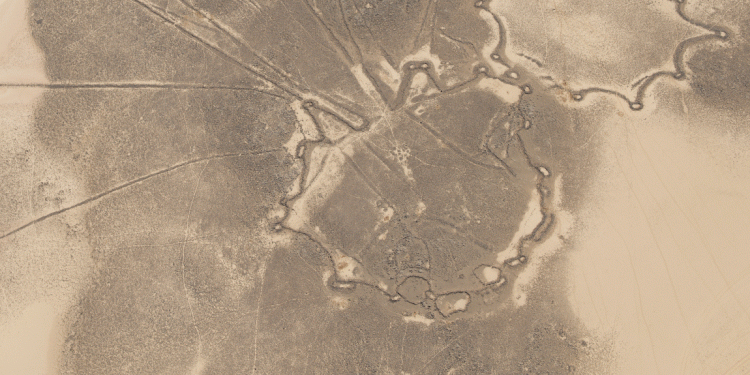In northern Saudi Arabia and southern Iraq, more than 350 monumental hunting structures, known as “kites,” have been identified and mapped using satellite images.
Michael Fradley, an Oxford archaeologist, led a team of researchers involved in the Endangered Archeology in the Middle East and North Africa (EAMENA) project that closely examined an area rarely studied in the past, the eastern Nafud desert, using open-access satellite imagery. Our understanding of prehistoric connections and climate change in the Middle East has the potential to be changed by the surprising results published in The Holocene journal.
The monumental structures consist of a series of leading walls that form an enclosure, sometimes miles long, and low stone walls which form the enclosure. These structures were known as kites by early aircraft pilots. The purpose may have been to guide animals like gazelles to an area where they could be caught or killed. According to initial evidence, the ancient structures date back to around 8,000 BCE, as far back as the Neolithic.
Although kites are difficult to observe from the ground, satellite imagery and platforms such as Google Earth have recently enabled the discovery of new distributions of monumental objects.
In addition to the known distribution of these structures in eastern Jordan and areas surrounding southern Syria, some have also been identified for the first time in southern Iraq.
In a statement, Dr. Fradley stated that the structures were carefully designed. In terms of The so-called kite ‘heads’ can reach more than 100 meters in width, which isn’t that monumental, but the guiding walls (the so-called kite ‘strings’), which experts believe were built so animals such as gazelles could be directed to a specific location were very very long, some of which were several miles long.
Many of these newer examples have surviving walls that run for nearly four kilometers, often over very different terrain. It shows a great deal of skill that these structures were designed and constructed.
Over generations, considerable resources would have been devoted to building, maintaining, and rebuilding the kites, together with hunting and returning slaughtered remains to settlements or camps for further preservation. Researchers think these statues reflect the status, identity, and territoriality of the region through their exaggerated size and shape.
Symbols and rituals of the Neolithic peoples of the region include kites in their rock art, suggesting they occupied an important place within their religious and symbolic spheres. This architecture is strikingly different in scale from any other evidence of early Holocene architecture, from the kite heads to the careful traversal of guide walls over vast distances.
The researchers suggest that the people who built the kites inhabited temporary structures made of organic materials that have left no visible traces in current satellite image data.
It seems this new group of sites reveals a level of connectivity among North Arabian cities that had never been perceived before. The structures raise fascinating questions about who built them, who they were intended to feed, and how people were able to both survive and invest in them.
In the context of this new connection, the star-shaped distribution of kites now provides the first direct evidence of contact across the Nafud desert rather than around it. This underscores the importance of areas that are now desert under more favorable climatic conditions in allowing the movement of humans and wildlife. Kites are believed to have been built during a wetter and greener climatic period known as the Humid Period of the Holocene (between 9000 and 4000 BCE).
On the Al Labbah plateau in the Nafud desert, where there are no later Bronze Age funerary monuments, there was the greatest number of kites built. This suggests that a shift to a drier period resulted in some of these areas becoming too marginal to sustain the communities that once used these landscapes. This is in addition to the potential displacement of game species.
There is no definitive answer as to whether kites represent the movement of ideas or people or even their direction. As part of the project, which is funded by Arcadia Fund, scientists are now extending their survey work throughout these now-arid regions to understand climate change’s impact on these landscapes.
Join the discussion and participate in awesome giveaways in our mobile Telegram group. Join Curiosmos on Telegram Today. t.me/Curiosmos











